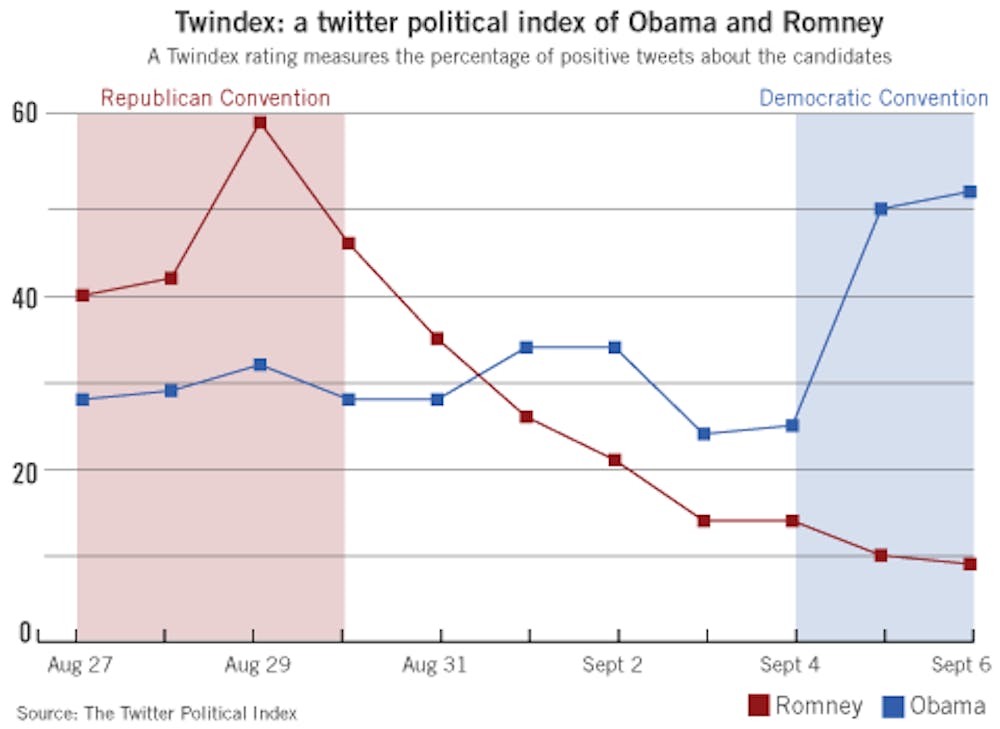Although Twitter has become the newest tool for measuring the success of political speeches and conventions, the technique still needs refinement.
Twitter and other research groups have tallied tweets per minute and total volume during the Republican and Democratic national conventions. Democratic National Convention speeches resoundingly beat speeches from their Republican counterparts.
President Barack Obama set a tweets-per-minute record at 52,757 during his keynote. Governor Mitt Romney reached a peak of 9,161 tweets per minute during his speech at the RNC.
However, volume of tweets is not enough to measure success, according to former Republican National Committee Online Director Cyrus Krohn. Krohn is now the co-founder of the social media consulting firm Crowdverb.
“Crowdverb puts a finite emphasis on the volume of tweets because there’s an echo chamber effect where people are just retweeting comments,” he said. “What the campaign consultants and strategists and others are not saying is, ‘OK, they’re talking about us, but what are they saying?’”
A new website launched by Twitter in August in partnership with research institutions The Mellman Group and The North Star and data analysis firm Topsy is attempting to look beyond merely volume. The Twitter Political Index (@Gov) has tracked positive and negative tweets about Obama and Romney since May 1. The site analyzes the semantics of individual tweets to determine whether or not a particular Twitter user is supportive of a candidate in his or her tweet.
Both candidates received bounces in the Twindex during their party’s conventions. Romney was at 60 on the Twindex on Aug. 29 — meaning that tweets about him were more positive than 60 percent of all other tweets — while Obama stayed at 32. On Sept. 6, Obama polled at 52 while Romney plummeted to 9.
Twindex’s history has not proved entirely compatible with traditional polling. The retroactively taken Twindex for Obama trended opposite of the president’s approval rating taken by Gallup in Sept. 2011.

John Dick, CEO of the Pennsylvania-based digital polling company CivicScience, cautioned that current technology has a limited ability to read semantics in tweets.
“It’s difficult to infer things like sarcasm,” he said.
Krohn echoed Dick’s sentiment. “They’re not really looking at the crafting of the phrase and the nuances of the written words in terms of what the emotional intent of parsing those words is,” he said.
Dick explained the very nature of sharing opinions on social media could be skewed, which could then affect semantics data.
“I generally only say something [on social media] when I have something interesting to say, which is at one extreme or another,” he said. People often do not give their honest, unabridged opinion on social media, Dick explained.
In addition, the Twitter population is not necessarily a reliable sample of the voter pool. More Democrats than Republicans are on Twitter, according to Dick. CivicScience completed a study of 11,455 undecided voters and concluded that those undecided were less likely than decided voters to be on Twitter. Thus, political tweets have a limited influence on swaying voters.
An exception, Dick said, is if a person didn’t see a political event but all of his or her friends did and posted about it via social media. In that case, the person might adopt the views of his or her friends.
Wharton sophomore Ivy McLendon tweeted her observations during both the RNC and the DNC. She said she is “heavily involved” in following politics.
“A lot of people follow me who are not going to watch the RNC, and they needed to know about it,” she said. McLendon identifies strongly as a libertarian but has not decided which of the two major party candidates to vote for. Currently she leans left.
As she made comments on speeches throughout the night, she said she got many retweets and replies, many of which were from people she did not know.
College sophomore Hector Kilgoe watched and tweeted about the DNC. Unless “something crazy happens,” he said, he plans to vote for Obama. He tweeted comments during speeches, some retweets from the official account of the Democratic party (@TheDemocrats) and some news articles, he added.
Some of Kilgoe’s tweets were straightforward, such as one praising Michelle Obama for understanding “the real America.” But others came with nuance that might be harder for current semantics software to understand.
“The girl performing at the DNC now has an okay voice, but she’s a terribly boring performer,” Kilgoe tweeted.
This tweet would have been difficult for the Twindex to rate.
Krohn explained that many of the social media analysis technologies only look at “thumbs up or thumbs down” as opposed to a deeper analysis.
“The next phase of the evolution of digital analysis is why are people talking and what are they saying and what is the implication of that conversation,” he added.




